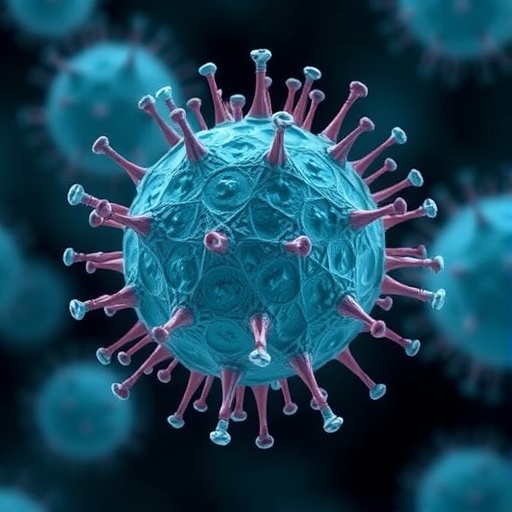
The COVID-19 pandemic has generated an urgent demand for understanding the complex immunological responses triggered by the SARS-CoV-2 virus, particularly in patients suffering from acute respiratory distress syndrome (ARDS). Recent research conducted by a team led by scholars Yang, Wang, and Huang shines a powerful light on this critical area of inquiry. In a groundbreaking study published in Scientific Natural, this team employed single-cell sequencing analyses combined with advanced machine learning techniques to uncover novel biomarkers associated with the immune response in the context of COVID-19-induced ARDS. This presents a significant advancement in the field and bears far-reaching implications for future diagnostic and therapeutic strategies.
The researchers meticulously explored the single-cell transcriptomic landscape of lung tissue samples obtained from COVID-19 patients exhibiting severe symptoms of ARDS. The careful and systematic analysis of gene expression profiles at single-cell resolution revealed startling insights into immune cell dynamics during the pandemic. Notably, their study pinpointed two immune-associated genes, SERPINB1 and CPEB4, as distinctive biomarkers linked to the severity of ARDS in COVID-19 patients. Understanding such biomarkers can pave the way for better patient stratification and management based on individual immune profiles.
SERPINB1, or serpin family B member 1, plays a notable role in the regulation of immune responses and inflammation. The study demonstrated that increased expression levels of SERPINB1 were associated with heightened inflammation and poor clinical outcomes in patients suffering from ARDS due to COVID-19. This underscores SERPINB1’s potential as a therapeutic target. By manipulating its expression or function, researchers might develop new strategies to quell excessive inflammatory responses that characterize severe cases of ARDS.
On the other hand, CPEB4, which stands for cytoplasmic polyadenylation element binding protein 4, is involved in mRNA regulation and cellular stress responses. Its elevated expression in COVID-19 patients hints at its critical involvement in modulating the cellular response to viral infections. Understanding CPEB4’s mechanistic role could provide novel insights into how cells respond to stressors like viral infections and inform our approaches to mitigate ARDS symptoms in infected patients.
Utilizing multiple machine learning methods, the researchers classified immune cell types and their states, leading to a more nuanced understanding of how specific immune responses contribute to COVID-19 pathology. These algorithms processed vast amounts of data—ideally suited for contemporary challenges in bioinformatics. By integrating diverse datasets, they achieved improved accuracy in delineating immune signatures that correlate with clinical outcomes.
This kind of research epitomizes the synergy of big data and biotechnology. The combination of rigorous biological experimentation with sophisticated computational methodologies is reshaping our grasp of complex diseases like COVID-19. The case of SERPINB1 and CPEB4 illustrates how high-dimensional data can be distilled into meaningful biological insights that transcend conventional methods.
The novel biomarkers identified by Yang et al. underscore the heterogeneity present in the immune responses to SARS-CoV-2. Patients exhibit varied clinical outcomes owing to multifactorial influences, including individual genetic predispositions, prior immune history, and other underlying health conditions. Identifying unique biomarkers like SERPINB1 and CPEB4 aids clinicians in personalizing treatment regimens, ultimately enhancing patient care and prognosis.
Acronyms are crucial in scientific discourse, and researchers have utilized them judiciously in their study. COVID-19 refers to the novel coronavirus disease identified in 2019, while ARDS denotes acute respiratory distress syndrome—two prominent terms that define the narrative of the ongoing pandemic. As research progresses, a greater comprehension of these acronyms’ clinical implications grows ever more paramount.
Furthermore, the timing of the study is particularly relevant. As researchers worldwide race to unravel SARS-CoV-2’s complexities, the continuous influx of new insights into immunology will help inform public health strategies. While vaccines and antiviral treatments have dominated headlines, understanding innate and adaptive immune responses is equally critical for addressing long-term consequences of COVID-19 infection.
Beyond immediate clinical significance, the findings might serve as a template for future research into other viral infections causing similar respiratory distress syndromes. By establishing a foundation for biomarker discovery, the study holds promise for advancing how we tackle not just COVID-19 but also other viral pathogens imposing similar health challenges on global populations.
Moreover, as the scientific community builds upon these biomarkers, collaborative multidisciplinary efforts are warranted. By fostering partnerships between computational and experimental biologists, researchers can leverage the power of machine learning and artificial intelligence to uncover additional insights. This cross-pollination of ideas is likely to accelerate discoveries, bringing forth a new era in disease management.
As we continue to unravel the intricacies of COVID-19, it’s imperative to recognize that each study contributes a vital piece to the larger puzzle. The work conducted by Yang et al. is a testament to the progress being made, equipping clinicians with more robust mechanisms for diagnosis and treatment. Societal resilience hinges on scientific discovery, and studies like this one remind us that hope often lies at the intersection of innovation and inquiry.
In sum, the identification of SERPINB1 and CPEB4 as novel immune biomarkers for COVID-19-induced ARDS underscores both the challenges and triumphs faced in the quest for knowledge amidst a global pandemic. This breakthrough offers pathways for optimized patient management strategies, enhanced therapeutic interventions, and invites further investigation into the cellular intricacies underpinning viral pathologies. The future holds immense promise as the understanding of our immune system evolves alongside our experiences with emerging infectious diseases.
In the aftermath of the pandemic, as we navigate the landscape of post-COVID recovery, the insights generated from this essential research will help sculpt a more resilient public health framework. Establishing clear connections between immune responses and clinical outcomes is vital in preparing society for the next wave of infectious challenges, ultimately safeguarding health and well-being for generations to come.
Subject of Research: COVID-19-induced ARDS biomarkers
Article Title: Single-cell sequencing analysis and multiple machine learning methods identified immune-associated SERPINB1 and CPEB4 as novel biomarkers for COVID-19-induced ARDS.
Article References: Yang, H., Wang, W., Huang, J. et al. Single-cell sequencing analysis and multiple machine learning methods identified immune-associated SERPINB1 and CPEB4 as novel biomarkers for COVID-19-induced ARDS. Sci Nat 112, 64 (2025). https://doi.org/10.1007/s00114-025-02016-9
Image Credits: AI Generated
DOI: https://doi.org/10.1007/s00114-025-02016-9
Keywords: COVID-19, ARDS, SERPINB1, CPEB4, single-cell sequencing, machine learning, biomarkers, immunology
Tags: Acute respiratory distress syndromeadvanced machine learning in healthcareAI in medical researchCOVID-19 biomarkersdiagnostic advancements in COVID-19gene expression profiling in COVID-19immune response to SARS-CoV-2immunological responses in COVID-19patient management strategies for ARDSSERPINB1 and CPEB4 biomarkerssingle-cell sequencing analysistherapeutic implications of COVID-19 research




